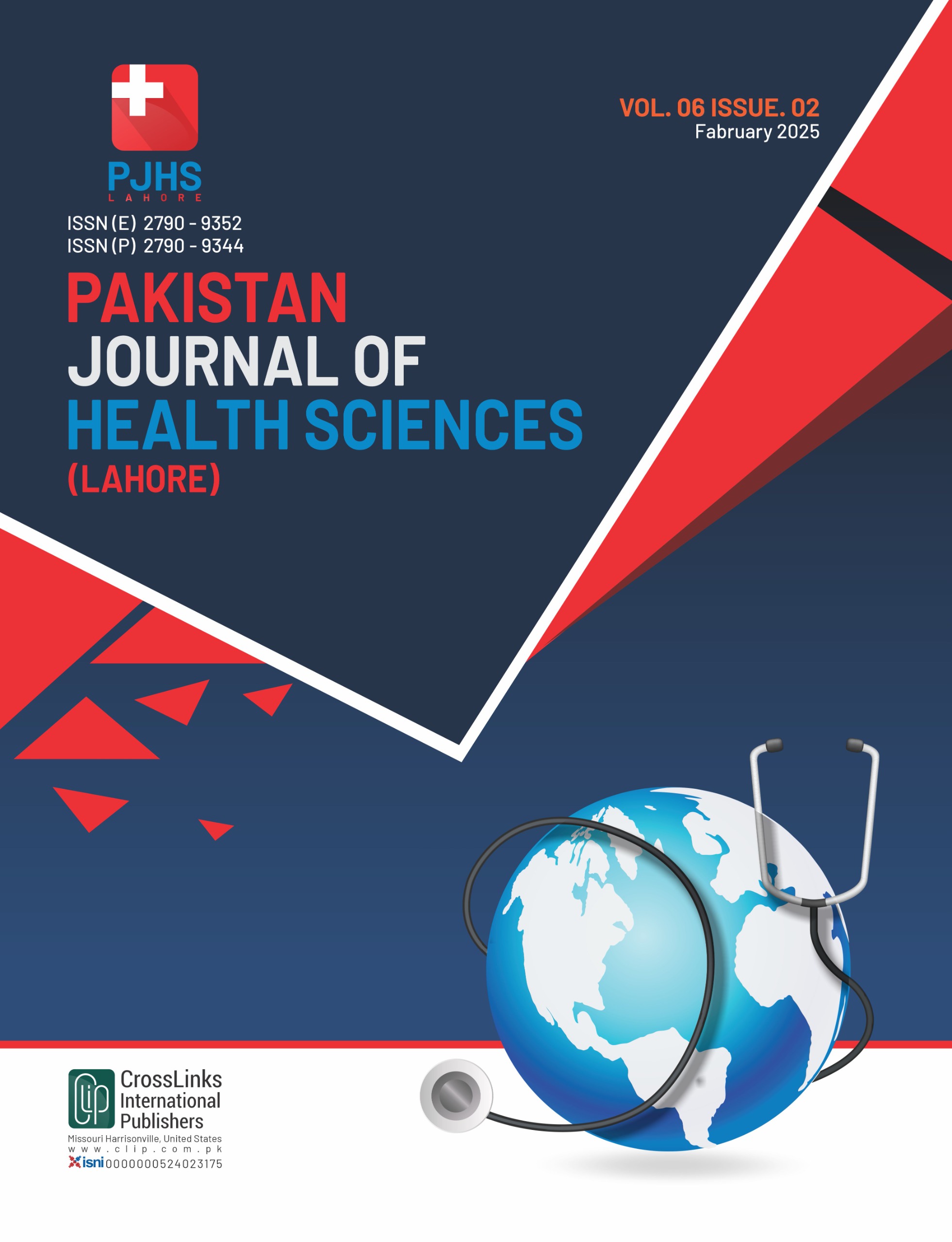Indications and Frequencies of Elective and Emergency Cesarean Section in Social Security Landhi Hospital Karachi, Pakistan
Indications and Frequencies of Elective and Emergency Cesarean Section
DOI:
https://doi.org/10.54393/pjhs.v6i2.2713Keywords:
Elective Cesarean, Emergency Cesarean, Dystocia, Antepartum HemorrhageAbstract
The cesarean section rate is high in Pakistan as compared with WHO recommendations. It is quite high in the public sector hospitals due to high-risk pregnancies repeat cesarean sections and referrals from private sector hospitals. Objectives: To determine the proportions of indications of elective and emergency cesarean sections. Methods: This cross-sectional study was carried out in the Department of Obstetrics and Gynecology, Social Security Landhi Hospital, Karachi, from January 1st, 2023 to December 31st, 2023. A total of 1150 patients were enrolled with a convenient sampling technique. Performa was filled by patients who delivered by cesarean section and through vaginal delivery. Patients who attended the Obstetrics patient’s department were marked as booked cases and those who were admitted for early labor and later cesarean-section was performed, were marked as un-booked. Cesarean sections through emergency were also included. Patients of ruptured uterus were excluded from this study. Data were entered in SPSS software version 24.0 and analyzed for frequencies and percentages. Results: A total of 770 cesarean sections were done. Overall frequency of cesarean-sections was 66.95%. Frequency of elective and emergency cesarean-section was 485 (62.98%) and 285 (37.01%). Booked cases were 658 (85.45%) while un-booked were 112 (14.54%). The commonest indication was repeat cesarean-section in 150 (19.48%), cervical dystocia in 105 (13.63%), fetal distress in 103 (13.37%), and antepartum hemorrhage were 94 (12.20%) patients. Conclusions: It was concluded that the Cesarean-sections rate was very high as compared to normal vaginal deliveries. The most common indication of cesarean section was repeat cesarean section.
References
Kumawat U and Natu N. The Rate and Indication of Caesarean Section in A Tertiary Care Centre.
International Journal of Medical and Biomedical Studies. 2020; 4: 10-32553. doi: 10.32598/ijmtfm.v10i3.32553. DOI: https://doi.org/10.32598/ijmtfm.v10i3.32553
Sabir SF, Baig FS, Safdar Z, Zeb S, Tariq F, Shehzadi K. Rising Cesarean Section Rate, need to Revisit Cesarean Section Indications. Pakistan Journal of Medical and Health Sciences. 2022 May; 16(04): 687-. doi: 10.53350/pjmhs22164687. DOI: https://doi.org/10.53350/pjmhs22164687
Manzour A, El-Khalek A, Labib K, Marzouk D, Abou-Taleb Y. Rate, Indications and Fetal Outcome of Cesarean Section Deliveries at A University Hospital in Cairo. Journal of High Institute of Public Health. 2020 Apr; 50(1): 39-45. doi: 10.21608/jhiph.2020.83663. DOI: https://doi.org/10.21608/jhiph.2020.83663
Comparative Study between Emergency and Elective Cesarean Section: Indications/Complications, A Hospital Based Study. 2020; 23(7): 966-969. doi: 10.36295/ASRO.2020.23721. DOI: https://doi.org/10.36295/ASRO.2020.23721
Rydahl E, Declercq E, Juhl M, Maimburg RD. Cesarean Section On a Rise—Does Advanced Maternal Age Explain the Increase? A Population Register-Based Study. Plos One. 2019 Jan; 14(1): e0210655. doi: 10.1371/journal.pone.0210655. DOI: https://doi.org/10.1371/journal.pone.0210655
Wahabi H, Fayed A, Elmorshedy H, Esmaeil SA, Amer YS, Saeed E et al. Prediction of Emergency Cesarean Section using Detectable Maternal and Fetal Characteristics among Saudi Women. International Journal of Women's Health. 2023 Dec: 1283-93. doi: 10.2147/IJWH.S414380. DOI: https://doi.org/10.2147/IJWH.S414380
Patel BS, Patel AB, Patel AJ, Banker DA, Patel MB. Maternal and Neonatal Outcome in Elective Versus Emergency Cesarean Section in A Tertiary Healthcare Centre in Ahmedabad, Western India. British Journal of Medical and Health Sciences. 2020 May; 2(5): 31-40.
Patel BS, Kedia N, Shah SR, Agrawal SP, Patel VB, Patel AB. Changing Trends in Cesarean Section: from 1950 to 2020. International Journal of Reproduction, Contraception, Obstetrics and Gynecology. 2020 May; 9(5): 2222-6. doi: 10.18203/2320-1770.ijrcog20201842. DOI: https://doi.org/10.18203/2320-1770.ijrcog20201842
Khatun A, Khatun T, Rahman S, Khatun MS, Farhin KK, Sultana R et al. Indications and Outcomes of Maternal and Neonatal Health among Emergency Cesarean Section-a Retrospective Study. Age. 2023; 21(5): 5-00.
Hanif Khowaja BM, Naz S, Valliani K, Maknojia AN, Ali AA, Maknojia MZ et al. Indications and Outcomes of Emergency and Elective Cesarean Section Deliveries in a Tertiary Care Hospital in Karachi, Pakistan: A Retrospective Study. Journal of Asian Midwives. 2024 Jul; 11(2). doi: 10.71071/JAM/v11i2.1.12. DOI: https://doi.org/10.71071/JAM/v11i2.1.12
Kanji Z, Simonovich SD, Najmi N, Bishop-Royse J. Examining Clinical Indications for Cesarean Section in A University Hospital in Karachi, Pakistan. Journal of Asian Midwives. 2019; 6(1): 14-25.
Dorji T, Wangmo K, Dorjey Y, Dorji N, Kiran Chhetri D, Tshering S et al. Indications and Factors Associated with Cesarean Section in Bhutan: A Hospital‐Based Study. International Journal of Gynecology and Obstetrics. 2021 Jun; 153(3): 520-6. doi: 10.1002/ijgo.13506. DOI: https://doi.org/10.1002/ijgo.13506
Khemworapong K, Sompagdee N, Boriboonhirunsarn D. Decision-to-Delivery Interval in Emergency Cesarean Delivery in Tertiary Care Hospital in Thailand. Obstetrics and Gynecology Science. 2018 Jan; 61(1): 48-55. doi: 10.5468/ogs.2018.61.1.48. DOI: https://doi.org/10.5468/ogs.2018.61.1.48
Guan P, Tang F, Sun G, Ren W. Prediction of Emergency Cesarean Section by Measurable Maternal and Fetal Characteristics. Journal of Investigative Medicine. 2020 Mar; 68(3): 799-806. doi: 10.1136/jim-2019-001175. DOI: https://doi.org/10.1136/jim-2019-001175
Meena N, Parveen S, Nagar T, Meena NK. Study of Indications of Primary Cesarean Section in Multigravida Patients: A Retrospective Study. Asian Journal of Medical Sciences. 2022 Jul; 13(7): 145-8. doi: 10.3126/ajms.v13i7.43663. DOI: https://doi.org/10.3126/ajms.v13i7.43663
Nair RV, Sowbharnika CP, Seetha PM. A Clinical Study on Indication for Cesarean Section Among Primigravida in A Tertiary Care Centre. Obstetrics Gynecology Reproduction. 2019; 5(2): 119-24.
Mostafayi M, Imani B, Zandi S, Rabie S. Comparing Early Postoperative Maternal Complications in Elective and Emergency Cesarean Sections. Journal of Midwifery and Reproductive Health. 2020 Jul; 8(3). doi: 10.18332/ejm/137366. DOI: https://doi.org/10.18332/ejm/137366
Naeem A, Anwer A, Sajjad S. Caesarean Section: Indications and Rate of Caesarean Section in Prim gravida. The Professional Medical Journal. 2018 Sep; 25(09): 1338-41. doi: 10.29309/TPMJ/2018.25.09.101. DOI: https://doi.org/10.29309/TPMJ/18.4648
Taj N, Jan F, Taj G, Anwar F, Mengal MH, Taj S. Study to Determine the Indications and Frequency of Elective and Emergency Caesarean Section in A Tertiary Care Hospital. In Medical Forum Monthly. 2021; 32(2).
Coskun B, Pay RE, Coskun B, Simsir C, Dur R, Colak E et al. Comparison of Emergency and Elective Cesarean Sections in the Breech Presentation: A Case-Control Study. 2020 Jun; 16(2): 114-9. DOI: https://doi.org/10.5222/BMJ.2020.27247
Tun MH, Chari R, Kaul P, Mamede FV, Paulden M, Lefebvre DL et al. Prediction of Odds for Emergency Cesarean Section: A Secondary Analysis of The CHILD Term Birth Cohort Study. Plos One. 2022 Oct; 17(10): e0268229. doi: 10.1371/journal.pone.0268229. DOI: https://doi.org/10.1371/journal.pone.0268229
Kitaw TM, Limenh SK, Chekole FA, Getie SA, Gemeda BN, Engda AS. Decision to Delivery Interval and Associated Factors for Emergency Cesarean Section: A Cross-Sectional Study. Baseboard Management Controller Pregnancy and Childbirth. 2021 Dec; 21: 1-7. doi: 10.1186/s12884-021-03706-8. DOI: https://doi.org/10.1186/s12884-021-03706-8
Idris IM and Menghisteab S. Cesarean Section Delivery Rates, Determinants, and Indications: A Retrospective Study in Dekemhare Hospital. Global Reproductive Health. 2022 Apr; 7(1): e56. doi: 10.1097/GRH.0000000000000056. DOI: https://doi.org/10.1097/GRH.0000000000000056
Downloads
Published
How to Cite
Issue
Section
License
Copyright (c) 2025 Pakistan Journal of Health Sciences

This work is licensed under a Creative Commons Attribution 4.0 International License.
This is an open-access journal and all the published articles / items are distributed under the terms of the Creative Commons Attribution License, which permits unrestricted use, distribution, and reproduction in any medium, provided the original author and source are credited. For comments













